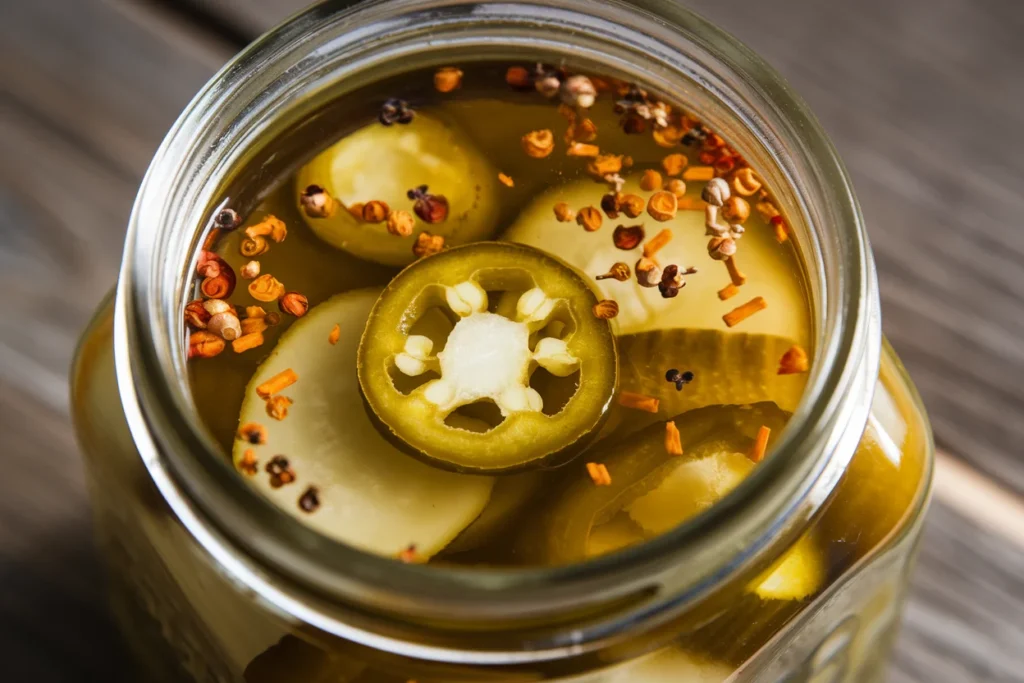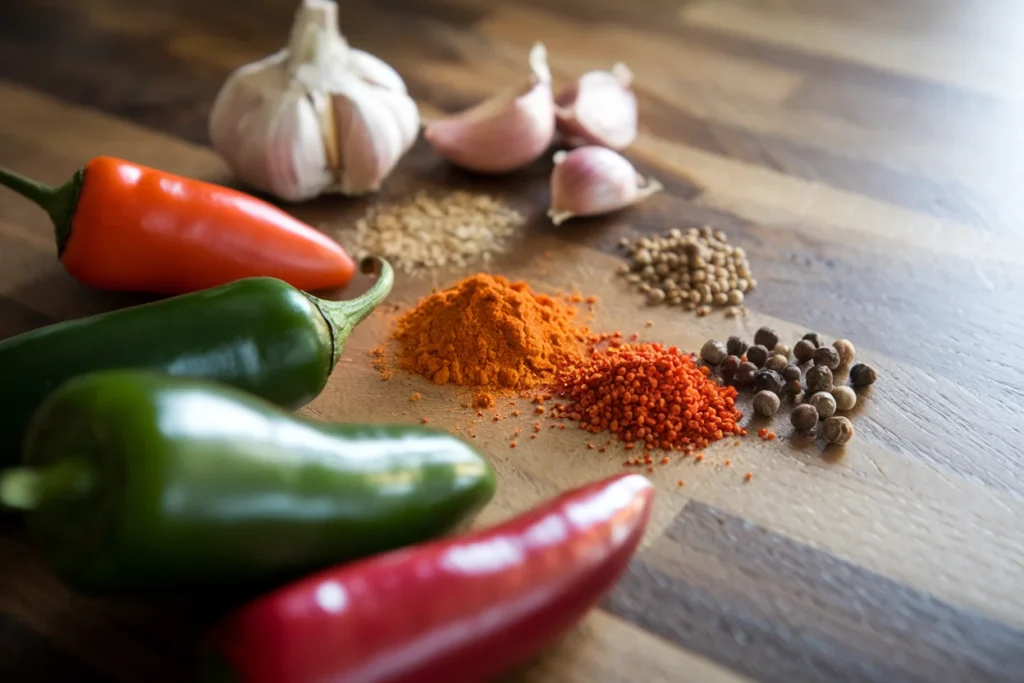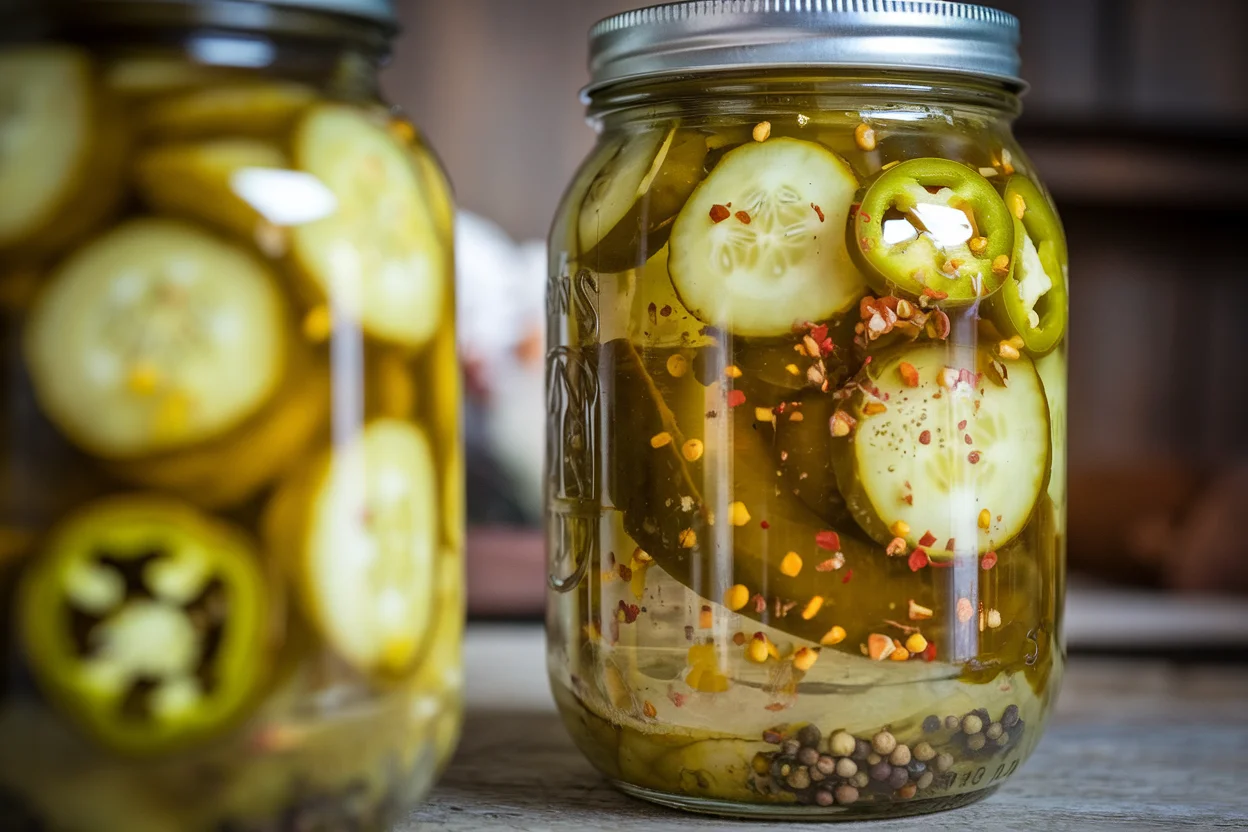Hot pickles are a popular treat for those who love a spicy kick with their crunchy, tangy snack. But what exactly makes a hot pickle hot? The answer lies in the ingredients, especially the peppers and spices used in the pickling process. Understanding the science behind the heat in pickles is key to mastering the art of creating a balanced, flavorful pickle that delivers the right amount of heat without overwhelming the palate. In this article, we will dive into the science, ingredients, and techniques behind creating the perfect hot pickle.
Table of Contents
If you’re looking to spice up your pickles, check out 5 Sensational Ways to Spice Up Pickles for more creative ideas.
The Science Behind the Heat in Pickles
To truly understand what makes a hot pickle hot, we need to explore the science behind it. The sensation of heat in your mouth when you bite into a hot pickle is caused by a compound called capsaicin. This compound is what gives chili peppers their characteristic spiciness.
The Role of Capsaicin in Spicy Pickles
Capsaicin is the active component in hot peppers that triggers a burning sensation when it comes into contact with the skin or mucous membranes. When you eat a hot pickle, the capsaicin interacts with the receptors in your mouth, sending signals to your brain that are interpreted as heat. Capsaicin does not actually cause physical damage or burns, but rather stimulates the pain receptors, making you feel the heat.
The more capsaicin present in the pepper used to make the pickles, the hotter the pickle will be. This is why certain peppers are used more often than others in hot pickle recipes, as they have a higher concentration of capsaicin.
How Peppers Infuse Heat into Pickles

The process of infusing heat into pickles begins when the peppers are added to the brine. As the pickles sit in the brine, they absorb the flavor and heat from the peppers. The longer the pickles marinate, the more intense the flavor becomes, allowing the heat to penetrate deeply into the cucumber or other vegetables being pickled.
In addition to capsaicin, some peppers contain other compounds that contribute to their heat, such as piperine and allyl isothiocyanate, which can enhance the spicy experience of the pickle. The combination of these compounds gives each hot pickle a unique flavor profile, making each variety distinct.
Want more on homemade pickling? Explore this Easy Homemade Spicy Pickle Recipe for a step-by-step guide.
Key Ingredients in Hot Pickles
When it comes to hot pickles, the right ingredients are essential to achieving the desired level of heat. Beyond the peppers, several other elements come into play to create the perfect balance of spiciness and tanginess.

Types of Peppers Commonly Used
Peppers are the star of the show when it comes to making hot pickles. Some of the most commonly used peppers include:
- Jalapeño: A mild to medium heat pepper that adds a bright, fresh flavor to hot pickles.
- Habanero: Known for its intense heat, the habanero is perfect for those who want their pickles to pack a punch.
- Serrano: A slightly hotter pepper than the jalapeño, serranos add a more robust heat to your pickles.
- Cayenne: Often used in powder form, cayenne pepper gives pickles a fiery kick.
- Ghost Pepper: For the bravest pickle enthusiasts, ghost peppers deliver an extreme level of heat that’s not for the faint of heart.
These peppers vary in their heat levels and flavors, which allows for a wide range of spicy pickle creations. You can even experiment with combining different types of peppers to achieve the perfect level of heat.
Other Spicy Additives and Their Effects
In addition to peppers, there are other spices and additives that can contribute to the heat in hot pickles. These may include:
- Garlic: While not necessarily hot, garlic can enhance the flavor profile of hot pickles and complement the heat.
- Mustard seeds: These can add a slight heat and tanginess to the brine, boosting the overall flavor of the pickle.
- Black peppercorns: A common addition to pickles, black pepper adds a mild heat that works well with other spicy ingredients.
- Cinnamon: While not usually hot, cinnamon can lend a warm, aromatic spiciness that pairs nicely with hot peppers.
By incorporating these spices into the brine, you can add complexity and depth to the heat, making for a more dynamic pickle experience.
How to Create the Perfect Balance of Heat
Creating a perfect hot pickle is all about balancing the heat with other flavors like tanginess and sweetness. While heat is a central component, it shouldn’t overpower the overall taste. The goal is to create a pickle that has just the right amount of spice without being too much for the taste buds.
Adjusting Pepper Ratios
One of the easiest ways to adjust the heat level in your pickles is by experimenting with the ratio of peppers used in the recipe. For example, if you want a milder pickle, you can reduce the number of hot peppers or mix them with milder varieties. Conversely, if you want a spicier pickle, add more of the hotter varieties, like habaneros or ghost peppers.
The key is to find the right balance that suits your taste preferences. Don’t be afraid to experiment with different pepper combinations until you achieve the perfect level of heat.
Combining Heat with Tangy Flavors
In addition to heat, tanginess is a crucial component of any good pickle. The acidity of the brine helps to balance the heat from the peppers and makes the pickle more refreshing. Common ingredients used to create tangy brines include vinegar, lemon juice, and lime juice.
To create the perfect hot pickle, make sure that the heat from the peppers is balanced with the acidity of the brine. The combination of these flavors creates a harmonious pickle that is both spicy and tangy, with each bite delivering a satisfying punch.
Popular Varieties of Hot Pickles
Hot pickles come in many varieties, each with its unique flavor and heat profile. Whether you prefer a classic recipe or a regional specialty, there is a hot pickle out there for everyone.
Regional Hot Pickle Recipes
Different regions of the world have their own take on hot pickles. For example, in India, achar is a popular spicy pickle made with a variety of peppers and spices. In the Southern United States, Pickled Jalapeños are a staple, often used to top tacos, burgers, and other dishes.
Each region brings its own flair to hot pickles, with unique ingredients and preparation methods that reflect local tastes and traditions. If you’re interested in exploring regional hot pickle recipes, try experimenting with ingredients specific to your area.
Specialty and Artisan Hot Pickles
In recent years, artisan hot pickles have become a popular trend. These are often made with specialty peppers, unusual spices, and unique flavor combinations. For example, some artisanal hot pickles are made with exotic peppers like Scorpion or Caribbean Red Hots, while others might feature flavor infusions like dill, mustard, or even fruit.
Specialty hot pickles offer an opportunity to try new and exciting flavors, and they make great gifts for spice lovers or as unique additions to your own pantry.
For those interested in regional recipes, try this Pickled Sausage Recipe to bring some spice to your table.
Common Mistakes When Making Hot Pickles
While making hot pickles may seem simple, there are several common mistakes that can lead to subpar results. To avoid these pitfalls, it’s important to pay attention to the details of your recipe and ensure that you’re striking the right balance of flavors.
Overpowering Heat vs. Balanced Spice
One of the most common mistakes when making hot pickles is using too many hot peppers, leading to an overpowering heat that masks the other flavors in the pickle. While heat is essential, it’s crucial to strike the right balance between spice, tang, and sweetness.
To avoid this mistake, start with a smaller amount of peppers and gradually increase the amount as needed. You can always add more heat, but it’s much harder to tone it down once it’s too hot.
Choosing the Wrong Pickle Base
Another common mistake is choosing the wrong type of pickle base. For example, using a cucumber that’s too bitter or too soft can result in a mushy, unappetizing pickle. Always choose fresh, firm vegetables for your pickles, and make sure that the brine complements the natural flavor of the vegetable.
The Health Benefits of Spicy Pickles
Not only are spicy pickles delicious, but they also offer several health benefits, thanks to the capsaicin in the peppers and the antioxidants in the spices.
Capsaicin and Metabolism
Capsaicin has been shown to have a positive impact on metabolism. Studies suggest that capsaicin can help boost metabolism by increasing the rate at which your body burns calories. This makes spicy pickles a potentially helpful addition to a healthy diet, especially for those looking to boost their metabolism and increase fat burning.
Antioxidant Properties of Peppers
In addition to their metabolism-boosting properties, peppers are also rich in antioxidants, which help fight free radicals in the body and protect against cellular damage. The antioxidants found in peppers can contribute to overall health and well-being, making hot pickles not just a tasty snack, but a nutritious one as well.
Did you know pickled vegetables can be nutritious too? Discover more about their benefits in this Healthy Chicken Enchiladas Recipe.
Frequently Asked Questions About Hot Pickles: What You Need to Know
Hot pickles are a popular snack for those who enjoy a little spice with their tangy crunch. But what exactly makes them hot, and how do they differ from regular pickles? Below, we answer some common questions about hot pickles to help you understand what goes into making them and why they’re so irresistible.
What is in Hot Pickle?
Hot pickles are typically made with cucumbers that are soaked in a brine, much like regular pickles, but with added spicy ingredients. The key component that makes them hot is peppers, often jalapeños or habaneros, which infuse the brine with heat. Other spicy additives like garlic, mustard seeds, and even cayenne pepper can be added to enhance the flavor and heat. Capsaicin, the compound found in chili peppers, is what triggers the spicy sensation, making hot pickles a fiery snack.
What Happens if Pickles Get Hot?
If pickles are exposed to heat, several things can happen. First, the brine may become cloudy, which can affect the texture and flavor of the pickle. Overheating the pickles can cause them to become soft or mushy. Additionally, prolonged exposure to heat can cause the pickles to lose their crunch, a characteristic that makes them so appealing. To preserve pickles at their best, store them in a cool, dark place, such as the refrigerator, and avoid overheating during preparation.
What Makes Van Holten Pickles Hot?
Van Holten pickles, a popular brand known for its pickled products, achieves its signature heat through a blend of hot peppers, including jalapeños and sriracha. The company uses these peppers to infuse the brine with a spicy kick. The capsaicin from the peppers is what creates the intense heat in every bite, giving Van Holten pickles their signature “hot” flavor. If you’re looking for a spicier pickle, Van Holten offers various heat levels to suit different tastes.
What Makes a Pickle Glow?
The phenomenon of pickles “glowing” can be attributed to the natural fluorescence of certain compounds found in the cucumbers, especially when they are pickled with specific ingredients or stored in certain conditions. In some cases, if pickles are exposed to UV light, they may appear to glow. This is usually harmless and doesn’t affect the quality or safety of the pickle. However, in rare instances, chemical reactions with preservatives or added colorants might cause unusual effects, but these are generally safe and uncommon.
What Causes Pickles to Ferment?
Pickles ferment through a natural process that involves the transformation of sugars into lactic acid by bacteria. During fermentation, cucumbers are submerged in a brine solution made of water, salt, and sometimes vinegar. The lactic acid bacteria (LAB) feed on the sugars in the cucumbers, producing lactic acid, which gives pickles their signature tangy flavor. The fermentation process can take anywhere from a few days to several weeks, depending on the desired flavor intensity. For a quicker fermentation process, vinegar can be added to the brine.
What Makes Pickles Bright Green?
Pickles stay bright green thanks to a special compound called chlorophyll, which is found in the skin of the cucumber. When cucumbers are pickled, their color can change due to the salt and vinegar in the brine, but chlorophyll helps preserve the cucumber’s natural green color, especially if the pickles are processed quickly. The use of specific pickling techniques and fresh cucumbers can also help maintain that vibrant green hue, while exposure to heat or prolonged storage can cause the pickles to lose their color.
Conclusion
What makes a hot pickle hot? It’s the combination of the right peppers, spices, and techniques that create a deliciously spicy treat. From the science of capsaicin to the health benefits of spicy ingredients, there’s much more to hot pickles than meets the eye. Whether you’re looking to create your own hot pickle recipe or simply enjoy the unique flavor of store-bought varieties, understanding the key elements behind their heat will help you appreciate this beloved snack even more.

